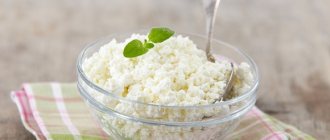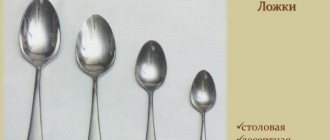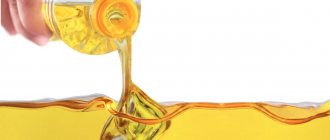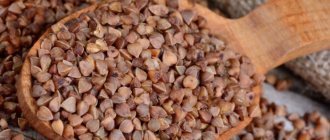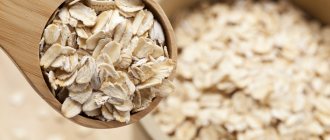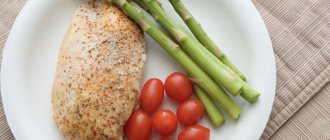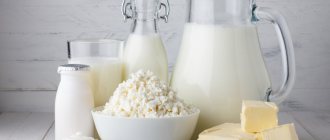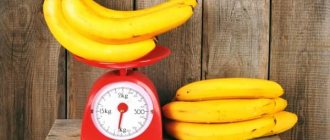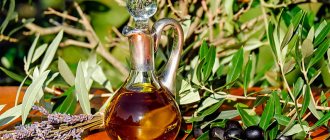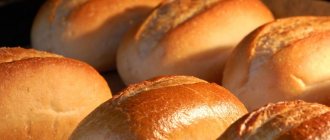When preparing almost any dish, we measure the amount of necessary ingredients in our usual ways, be it a glass, cup or spoon. And everything would be fine, but not everyone’s glasses and cups are the same, and many recipes indicate the weight of the desired product in grams.
In such cases, an indispensable thing is a measuring cup, which indicates both the number of milliliters for various types of liquids and the weight in grams for dry products. Even with this useful kitchen appliance, it doesn't hurt to know the capacity of the utensils most commonly used when preparing food.
A teaspoon contains 5 ml of water, a tablespoon is three times more, that is, 15 ml; The faceted glass familiar to everyone, which is also called “Stalinist” or “Soviet”, comes in two types - with and without a smooth rim. A glass with a rim is considered a tea glass, since it was in it that conductors on trains served tea throughout the carriage; the volume of this glass is 250 ml; the same glass, but without the rim - 200 ml.
It is important to remember that the volume of the dishes is not always equal to the weight of the product. For approximate data, a table of measures and weights of products may be useful. Many dry foods weigh much less in grams than their volume in milliliters.
The tables below offer weight-equivalent volumes in grams, breaking down foods into convenient subcategories.
Note: The table of measures and weights of products in grams is designed taking into account the filling of dishes as follows:
- spoon - with a small slide;
- glass - to the brim;
- jar - up to the neck.
Bulk products
This type includes cereals, sugar, salt, flour and some others. The table for measuring the weight of bulk products offers the main methods of measurement - a spoon and a glass, dividing them into several types, according to volume. For the convenience of preparing large portions, half-liter and liter jars were added.
Always read the recipe carefully - one cup of flour does not mean 200g of flour, even if your cup is slightly larger than 200ml. Remember that in a “Stalinist” tea glass, filled to the brim, there is only 160 g of flour.
Note: If you don’t have a traditional cut glass on hand in your kitchen, you can replace it with a plastic one. A standard transparent disposable polypropylene glass holds exactly 200 ml of water.
| Product name | Measures of weight in grams | ||||||
| Spoon | Cup | 0.5 liter jar | 1 liter jar | ||||
| tea room | dessert | dining room | 200 ml | 250 ml | |||
| Salt | 13 | 25 | 40 | 255 | 320 | 640 | 1280 |
| Bulgur | 8 | 15 | 25 | 190 | 235 | 470 | 940 |
| Peas | 8 | 15 | 25 | 185 | 230 | 460 | 920 |
| Pearl barley | |||||||
| Rice | |||||||
| Couscous | 8 | 15 | 25 | 180 | 225 | 450 | 900 |
| Millet | 8 | 15 | 25 | 175 | 220 | 440 | 880 |
| Buckwheat | 7 | 15 | 25 | 165 | 210 | 420 | 840 |
| Sugar | 10 | 20 | 30 | 160 | 200 | 400 | 800 |
| Semolina | 8 | 15 | 25 | ||||
| Corn flour | 10 | 20 | 30 | 145 | 180 | 360 | 720 |
| Wheat groats | |||||||
| Barley groats | |||||||
| Wheat flour | 8 | 15 | 25 | 130 | 160 | 320 | 640 |
| Powdered milk | 4 | 8 | 15 | 100 | 120 | 240 | 480 |
| Oat flakes | 5 | 10 | 15 | 80 | 100 | 200 | 400 |
| Hercules | 4 | 9 | 15 | 60 | 75 | 150 | 300 |
| Cornflakes | 3 | 6 | 10 | 50 | 60 | 125 | 250 |
How many grams are in a teaspoon of food (table):
This table shows the weight of the ingredients in grams in an average-sized teaspoon - 13 cm.
| Product name | Without slide in grams | With a slide in grams |
| How many grams of water in a teaspoon | 6 | — |
| How many grams of sugar in a teaspoon | 7 | 9 |
| How many grams of coarse salt | 7 | 9 |
| How many grams of fine salt in a teaspoon | 8 | 10 |
| How many grams of flour in a teaspoon | 5 | 7 |
| How many grams of honey in a teaspoon | 10 | — |
| Whole milk | 6 | — |
| Powdered milk | 7 | 9 |
| Condensed milk | 12 | — |
| Cream | 5 | — |
| Cottage cheese | 11 | 13 |
| Sour cream | 11 | 14 |
| Vegetable oil | 7 | — |
| Liquid ghee | 6 | — |
| Butter | 7 | 9 |
| Linseed oil | 5 | — |
| Flax seeds | 4 | 6 |
| Tomato paste | 11 | 13 |
| Tea | 2 | 4 |
| Cocoa powder | 4 | 6 |
| Ground coffee | 5 | 7 |
| Rice | 7 | 9 |
| Buckwheat | 5 | 7 |
| Cereals | 3 | 5 |
| Cornflakes | 2 | 4 |
| Semolina | 6 | 8 |
| Pearl barley | 6 | 8 |
| Beans | 9 | 11 |
| Peas | 6 | 8 |
| Ground crackers | 5 | 7 |
| Dry yeast | 3 | 5 |
| Fresh yeast | 11 | — |
| Jam | 5 | — |
| Raisin | 5 | 7 |
| Ground nuts | 5 | 7 |
| Dried mushrooms | 2 | 4 |
| Vinegar 9% | 6 | — |
| Ground black pepper | 5 | 7 |
| Citric acid granules | 5 | 6 |
| Soda | 7 | 9 |
| Starch | 3 | 4 |
| Gelatin | 4 | 6 |
| Mayonnaise | 12 | 14 |
| Copper sulfate | 20 | 22 |
Delicious recipe! Temperature while eating
Spices and additives (ground)
Since the preparation of most dishes requires little spice, the main measurements are teaspoons and tablespoons. For convenience, a dessert spoon was added, the standard volume of which is 10 ml. Weights of food in spoons are not equivalent to their volume.
The weight of most spices and additives depends on the grind and quality of the product. For example, coarsely ground coffee will weigh slightly more than finely ground coffee.
Note:
- The table of weights and measures of products in grams does not guarantee an absolutely accurate weight, since the consistency and size of many products are not always the same.
- Very often, spices are measured in pinches; one pinch contains about a quarter of a teaspoon.
| Product | Product weight | |||
| Tea spoon | Dessert spoon | Tablespoon | ||
| Baking soda | 12 | 24 | 45 | |
| Starch | 10 | 20 | 30 | |
| Powdered sugar | ||||
| Lemon acid | 8 | 15 | 25 | |
| Baking powder | ||||
| Cocoa | ||||
| Cinnamon | 7 | 13 | 20 | |
| Ground coffee | ||||
| Poppy | 6 | 12 | 18 | |
| Gelatin | 5 | 10 | 15 | |
| Pepper | ||||
| Breadcrumbs | ||||
| Mustard | 4 | 8 | 12 | |
| Instant coffee | 3 | 6 | 10 | |
| Carnation | ||||
How many grams are in a tablespoon of food (table):
This table contains a list of products, which are measured in grams. Moreover, you need to take into account that some products can be poured into a heaped or unheaped tablespoon. If you want to get acquainted with the measure in milliliters, then read the entry: How many ml. in a tablespoon and a teaspoon.
Another important point! The capacity of tablespoons may vary. This can be influenced by two things: the depth of the cup itself (scoop) and the design of the spoon. For example, a “table spoon” is slightly smaller than a menu spoon in both the length and depth of the cup. In this table, the weight of the ingredients was measured with a tablespoon measuring 21.3 cm in length. Based on the differences in models, the discrepancy may be approximately 3 grams.
A classic menu spoon holds 18 grams of water, a regular one, and a table spoon - 15 grams, although both are positioned as “table spoons”. In Russia, “tablespoons” are more often used.
| Product name | Without slide in grams | With a slide in grams |
| How many grams of water in a tablespoon | 18 | — |
| How many grams of sugar in a tablespoon | 20 | 25 |
| How many grams of coarse salt | 22 | 27 |
| How many grams of fine salt in a tablespoon | 25 | 30 |
| How many grams of flour in a tablespoon | 16 | 22 |
| How many grams of honey in a tablespoon | 30 | — |
| Whole milk | 19 | — |
| Powdered milk | 20 | 24 |
| Condensed milk | 36 | — |
| Cream | 16 | — |
| Cottage cheese | 35 | 40 |
| Sour cream | 33 | 43 |
| Vegetable oil | 20 | — |
| Liquid ghee | 17 | — |
| Butter | 20 | 25 |
| Linseed oil | 17 | — |
| Flax seeds | 13 | 20 |
| Tomato paste | 33 | 40 |
| Tea | 8 | 12 |
| Cocoa powder | 12 | 18 |
| Ground coffee | 16 | 22 |
| Rice | 20 | 27 |
| Buckwheat | 15 | 20 |
| Cereals | 10 | 16 |
| Cornflakes | 8 | 12 |
| Semolina | 17 | 23 |
| Pearl barley | 18 | 23 |
| Beans | 28 | 33 |
| Peas | 17 | 21 |
| Ground crackers | 14 | 20 |
| Dry yeast | 10 | 15 |
| Fresh yeast | 33 | — |
| Jam | 16 | — |
| Raisin | 15 | 20 |
| Ground nuts | 16 | 21 |
| Dried mushrooms | 8 | 13 |
| Vinegar 9% | 18 | — |
| Ground black pepper | 15 | 20 |
| Citric acid granules | 15 | 18 |
| Soda | 21 | 28 |
| Starch | 9 | 12 |
| Gelatin | 12 | 17 |
| Mayonnaise | 35 | 42 |
| Copper sulfate | 60 | 65 |
Delicious recipe! What sauce do you eat manti with?
Liquids
Liquids are almost always measured in milliliters, which makes cooking much easier since it is enough to know the volume of the container in which food is usually measured. When prescription liquids are measured in grams, their weight is as close as possible to the volume.
| Liquid product | Product weight in grams | ||||||
| Tea room (5 ml) | Dessert l. (10 ml) | Dining room l. (15 ml) | 200 ml | 250 ml | 500 ml | 1000 ml | |
| Water | 5 | 10 | 15 | 200 | 250 | 500 | 1000 |
| Milk | |||||||
| Cream | |||||||
| Liquor | |||||||
| Cognac | |||||||
| Vinegar | |||||||
| Ghee | 7 | 14 | 20 | 195 | 240 | 480 | 960 |
| Rendered fat | 5 | 10 | 15 | 195 | 240 | 480 | 960 |
| Sunflower\olive oil | 6 | 12 | 18 | 185 | 230 | 460 | 920 |
| Melted margarine | 5 | 10 | 15 | 180 | 225 | 450 | 900 |
How much cereal and nuts in a glass
Rice cereal is the most popular product in our country; we prepare various dishes from it almost weekly. Therefore, the question: a glass of rice - how many grams - is by no means idle. Rice porridge, risotto, boiled rice, pilaf - there are countless dishes with this grain, and therefore it is not superfluous to remember that in a 250 ml glass there will be as much as 240 grams of rice. If you have a small container of 200 ml, filling it to the top will give you 180 g. healthy cereal.
Iron-rich buckwheat is no less popular in our country; the benefits of buckwheat for human health are undeniable. The recent rise in prices, which almost every Russian has noticed, also indirectly indicates the unimaginable popularity of the product. Many people remember the battles for this cereal in stores, repeatedly shown on TV. Buckwheat grains have a non-standard shape, close to round, which is why there are small gaps between the grains that can be seen when pouring the grain into a transparent container. For this reason, less buckwheat will fit in a glass than, for example, rice. How many grams of buckwheat are in a glass? In faceted or plastic it is 165, and in tea it is all 210 g.
Tasty or not very tasty, with lumps or a pleasant consistency, semolina porridge is well known to our compatriots and residents of the CIS, one might say, from the cradle. But porridge is far from the only dish where this grain is needed. It is used for making cutlets, casseroles, pies and cakes. Inside a faceted glass will fit 160 grams of semolina, and a thin-walled tea cup filled to the top with cereal will hold 200 grams.
Solid foods
Note: The table of measures and weights of products in grams provides approximate data. The exact weight of products depends on their size and type.
| Product name | Measures of weight in grams | ||||||
| Spoon | Cup | 0.5 liter jar | 1 liter jar | ||||
| tea room | dessert | dining room | 200 ml | 250 ml | |||
| Candied fruit | 10 | 25 | 35 | 220 | 275 | 550 | 1100 |
| Beans | 5 | 15 | 20 | 175 | 220 | 440 | 880 |
| Small lentils | 5 | 15 | 20 | 175 | 220 | 440 | 880 |
| Whole peas | 5 | 15 | 20 | 160 | 200 | 400 | 800 |
| Large lentils | 5 | 18 | 25 | 160 | 200 | 400 | 800 |
| Ground walnut | 10 | 20 | 30 | 155 | 190 | 380 | 760 |
| Raisin | 10 | 20 | 30 | 155 | 190 | 380 | 760 |
| Cherry | 10 | 20 | 30 | 155 | 190 | 380 | 760 |
| Cranberry | 10 | 20 | 30 | 155 | 190 | 380 | 760 |
| Currant | 10 | 20 | 30 | 145 | 180 | 360 | 720 |
| Peanuts, shelled | 8 | 15 | 25 | 140 | 175 | 350 | 700 |
| Peeled hazelnuts | 8 | 15 | 25 | 140 | 175 | 350 | 700 |
| Whole shelled walnut | 10 | 20 | 35 | 135 | 170 | 340 | 680 |
| Strawberry | 8 | 15 | 25 | 135 | 170 | 340 | 680 |
| Peeled almonds | 10 | 20 | 30 | 135 | 170 | 340 | 680 |
| Raspberries | 5 | 10 | 20 | 120 | 150 | 300 | 600 |
Measuring powder without scales
Various culinary recipes mention a variety of measurements for powder: a tablespoon or teaspoon, a glass, grams. To avoid confusion, you need to choose a specific size for yourself and convert all weight categories to one measurement. It is more convenient to use the dining room and tea room.
Even using the same recipe, several housewives end up with dishes that are quite different in taste and appearance. Therefore, it is advisable to remember the most successful masterpiece in order to decide how much flour powder should be put into a spoon.
When mentioning a glass, they usually mean the standard Soviet glass container, which holds exactly 250 ml of water if poured full. A glass filled to the rim holds 200 ml. If the flour is poured flush with the edges, its weight is approximately 160 g, if along the rim - 130 g.
When you need to measure 500 g of a substance, it is not very convenient to count using utensils or glasses. Therefore, savvy housewives use the following method:
- purchase a paper kilogram bag of any type of product in a store;
- measure the height of the packaging with a ruler;
- divide the result in half, marking the strip directly on the bag;
- carefully cut the package along the intended line;
- Now each half contains approximately the same amount of the component - half a kilo.
It is convenient to use a special plastic transparent cup, on the wall of which there are weight measures of common products: flour, sugar, salt, water. But it is also advisable to fill such a container with the substance on top, rather than scooping the product from a bag or jar.
Peanut paste
Peanut butter is obtained from ground nuts, which are finely ground and mixed with salt and vegetable oil. This is a tasty and healthy product (subject to the recommended standards), a favorite delicacy of many Russians. Therefore, it will be useful for those who monitor their waist size to find out how many grams of the product and calories are in spoons:
- 1 tsp. – 12 gr. and 70 kcal;
- 1 tbsp. l. – 35 gr. and 205 kcal.
Sahara
The amount of granulated sugar inside the container needs to be known when making original desserts, pastries and jams. Such sweet dishes require a large amount of the ingredient, so measuring how many grams of sugar are in a glass is convenient. Having determined what volume the container is, you can begin counting the required mass of the component:
- a 200 ml glass contains 180 g of sugar;
- A 250 ml glass holds 200 g.
Rice cereal is a popular raw material for preparing delicious dishes from the cuisines of different countries. If you want to create an interesting product, you need to use the exact amount of an ingredient. Such recipes will require knowledge of how many grams of rice are in a glass. A 200 ml container will contain 180 g of white cereal. If the cup capacity is 250 ml, you can pour 240 g of product into it. When cooking, you need to remember that you must strictly follow the proportions of rice and water so that the result comes out the way you need.
The most common liquid on the planet is a measure of the volume of dishes. Knowing how much water is in a cut glass helps determine that it is 200 grams. The tea version of this container contains 250 ml of liquid. Experienced housewives use these measurements as a starting point when determining the mass of food without the help of a kitchen scale. The indicated nominal volume of the container depends on the water content inside, since this substance completely fills the container due to its density and elasticity. This fact is known to many from school physics courses.
